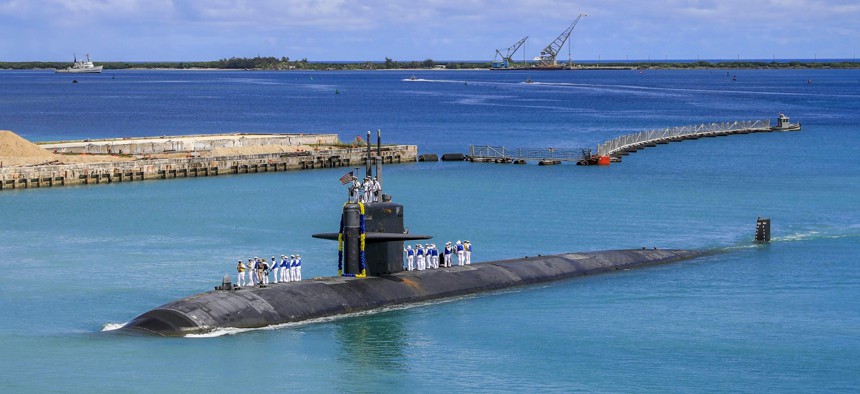
The Los Angeles-class fast attack submarine USS Oklahoma City returns to U.S. Naval Base in Guam, Aug. 19, 2021. U.S. Navy via AP / Mass Communication Specialist 3rd Class Naomi Johnson
Trade Versus Subs: The Risky U.S. Tradeoff in the Asia-Pacific
Which will matter more, a dozen more nuclear subs on the U.S. side of the ledger or a trade pact that could draw many of the world's largest economies ever-closer toward China?
The headline-grabbing announcement by the United States and the United Kingdom to help Australia build a fleet of nuclear-powered submarines could be a strategic masterstroke, helping Washington find an important military ally in countering China's growing naval might (it now boasts the world's largest, according to the Pentagon), while also reinvigorating U.S. alliances in the Pacific.
But a less noticed move on the same day could matter more: China's application to join a trade deal that the United States had brokered to counter China's rise—but then rejected due to internal political strife.
In effect, the moves are a bet: which will matter more a few decades from now, a dozen more nuclear subs on the U.S. side of the ledger or a trade pact that could draw many of the world's largest and most dynamic economies ever-closer toward China? For now, the U.S. decision has drawn the most headlines and attention—and for good reason.
Since developing nuclear-powered submarine technology in the 1950s, the United States has only shared it with one country, the United Kingdom. Sharing it now with Australia shows how important Washington views the need to bolster countries on the frontline of conflict with China.
The move also shows that Washington can still win over countries that at one point were unsure whether they had to choose between the United States and China.
As recently as 2018, Australian Prime Minister Scot Morrison said Australia could have it all—security via the United States and a dominant economic partner in China—declaring that "Australia doesn't have to choose."
The country's decision to buy up to a dozen nuclear-powered submarines effectively means it is now choosing, effectively gambling that Washington is in the Pacific to stay—a move that will likely improve morale among anxious U.S. allies, such as South Korea and Japan.
But the move could end up being a problem for Washington for two reasons. The move threatens to compound concerns in Europe about U.S. snubbing of allies, which has already been buffeted in recent months by the unilateral U.S. decision to pull out of Afghanistan. Now, it has blindsided France, nixing its plans to sell Australia conventionally powered submarines. French Foreign Minister Jean-Yves Le Drain saying it was "brutal, unilateral, and unpredictable."
This is about more than mercantilistic concerns, calling into question efforts to forge a common trans-Atlantic strategy to counter China's rise. Until now, both sides have been trying to find a common policy, for example in how to handle human rights violations in Xinjiang, Chinese expansion in the South China Sea, and threats to the self-governing island of Taiwan.
On Thursday, the European Union issued a Indo-Pacific strategy paper that underscored the group's desire to take that part of the world more seriously—something the United States has urged it to do for years. Many of the paper's concerns overlap those of the United States, part of a slow alignment of interests to strengthen democracy in Asia.
Now, such cooperation will be harder to achieve, with Washington signaling that cooperation is only a tactic that can be discarded when the chips are down.
But those risks to relations may pale in comparison to a potentially bigger issue—that the benefits of the submarines may matter less than the damage the United States has inflicted on itself in the realm of trade.
For most of the 2010s, the United States pushed a new trade deal called the Trans-Pacific Partnership (TPP) to bind together like-minded countries around the Pacific Rim in what would have been the world's largest free-trade deal covering 40 percent of the global economy. One goal was to reduce the countries' dependency on trade with China and boost U.S. leadership in the region.
The TPP was signed by a dozen countries, including the United States, in 2016. But it came under attack in that year's presidential election by Donald Trump as a jobkiller. When he won the presidency, the United States withdrew in 2017. The next year, the remaining signatories formed the Comprehensive and Progressive Agreement for Trans-Pacific Partnership (CPTPP). President Joe Biden has said he would only support the United States entering the deal if it were renegotiated.
China countered with its own trade deal, the Regional Comprehensive Economic Partnership, a less ambitious plan that has fewer provisions on labor and the environment.
On Thursday, however, China formally applied to join the CPTPP—seeking to turn the tables on the United States by joining the very trade pact that was designed to counter its rise. Over the past few months, it has held talks with Australia, Malaysia, New Zealand, and other nations about joining the group.
China's membership is far from assured. But it underscores the reality that China is the region's dominant economic power and that the United States is beset by so many internal battles that it cannot muster the will to join a group that its elites argued for a decade was vital to its strategic interests.
If China were to join and the United States remain on the sidelines, the sub deal could look anachronistic: an effort by Anglo-American countries to play their one, fading advantage—advanced military technology—while allowing China to use its economic power to draw countries inexorably into its orbit.
This piece, first published by the Council on Foreign Relations, is used with permission.



